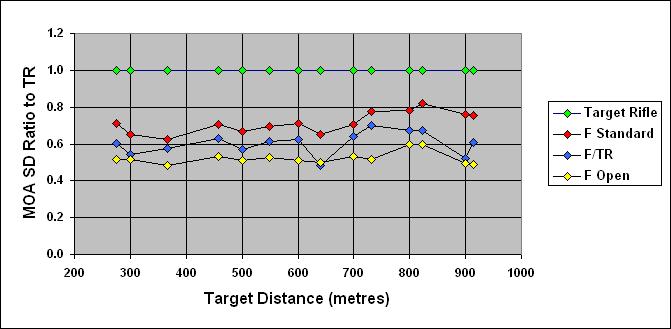If my methods are sound, then it appears that at Queens level, F/TR sits between F-Std and F-Open in terms of accuracy, slightly closer to F-Open in fact. Across all distances, F-Std groups are about 72% of TR, F/TR about 62%, and F-Open 53%. Because of the relatively small fields in F/TR, the stats are less reliable, as seen by its more erratic (blue) line on the graph below. The graph reveals that the best relative performance of TR occurs at around 800m to 900y. This suggests they may be better long range wind readers, but are disadvantaged significantly at 900m and 1000y by ballistically inferior projectiles. I'm puzzled by the fact that F-Std regains some lost ground after 900y. Is it because they run hotter loads?

Note that this comparison uses median scores, so may not reflect what you see with winning scores. The median score from each class at every Queens (not leadup) range in 2014 (there were 82) was input, and processed as follows :
- Scores were converted by adding Vs (or Xs) to points
- A Standard Deviation (in MOA) for each converted score was deduced using a typical shots profile for a given score
- For every one of the 82 ranges, the ratio of each F-Class SD to the TR SD was calculated
- For the graph and the overall figures, the SDs were summarised using some weighting according to the numbers in the classes.
I'll be producing new MCSI tables for 2015 based on these statistics. Until now, due to lack of F/TR data, they have had to be lumped in with F-Std. In hindsight, perhaps they should have been scored exactly halfway between F-Std and F-Open!




